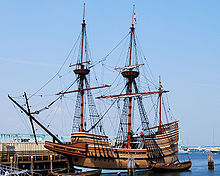Mayflower
![]()
The title of this article is ambiguous. For other meanings, see Mayflower (disambiguation).
The Mayflower was a sailing ship with which the "Pilgrim Fathers" (eng. Pilgrim Fathers), many of whom came from central England, set out for America to lead a new life there. The Mayflower set sail from Plymouth on 6 Sept. jul. / 16 Sept. 1620greg. and instead of reaching the desired destination of Virginia, reached Cape Cod, where the settlers disembarked on 11 Nov. jul. / 21 Nov. 1620greg. near the present site of Provincetown. During the crossing, two people died and one child was born. After two failed attempts to sail to Virginia after all during that stormy winter, the passengers finally wintered on the ship anchored again at the northern tip of Cape Cod Bay. In these horribly cramped and hygienically disastrous conditions, pneumonia and tuberculosis decimated the settlers, and among the dead were many children. On 21. Marchjul. / 31. March 1621greg. one began with the settlement of the coast with the future Plymouth (Massachusetts). The Mayflower set sail on 5 April Jul. / 15 April 1621greg. for the return voyage to England.
On board the Mayflower were 102 passengers and 31 crew. Captain of the ship was Christopher Jones. He had bought it with partners in 1607 or 1608 for the transport of goods between England and La Rochelle. Especially wine was imported from the mainland to the British island. The ship was about 28 metres long, 9 metres wide and had a draught of about 4 metres. The English merchant Thomas Weston had cabins built into the ship in 1619 (the narrowest ones in the lower deck were only about 80 × 50 cm) and organised the passage of the Pilgrims, most of whom, like himself, were members of the Calvinist group of separatists persecuted in England at the time.
Many US-Americans, especially the distinguished families of New England, try to trace their ancestry back to a passenger of the Mayflower. The "General Society of Mayflower Descendants" was founded in Plymouth (Massachusetts) in 1897.
The voyage of the Mayflower is the most prominent example of the settlement of the Americas by Europeans and is sometimes misrepresented as its beginning. In fact, however, the colonization of North America in modern times began as early as the mid-16th century with the settlement of Newfoundland, so the town of St. John's is considered the oldest British colony with its seizure by the English Crown in 1583, almost 40 years before the Mayflower's crossing.

Mayflower II , a replica of the Mayflower, undergoing repairs in Mystic Seaport in October 2017.
History of the Mayflower
Christopher Jones and several business partners bought the ship Mayflower around 1607. The origins before that are uncertain. Its first recorded voyage was to Trondheim in Norway in 1609. Andrew Pawling hired the ship to take a cargo of London goods to Norway, sell them and buy Norwegian goods (timber, tar, fish) to return to England. Unfortunately, the Mayflower encountered a severe North Sea storm on the return voyage, and the captain and crew were forced to throw most of Pawling's goods overboard to lighten the ship.
After that, Christopher Jones seems to have stuck to safer trade routes. The Mayflower made numerous voyages mainly to Bordeaux, France, returning to London with cargoes of French wine, cognac, vinegar and salt. The Mayflower could carry about 180 tons of cargo. The Mayflower also made occasional trips to other ports, including once to Malaga, Spain, and twice to Hamburg, Germany.
After returning from a voyage to Bordeaux, France, in May 1620, the Mayflower and Christopher Jones were hired to take the Pilgrims to Northern Virginia. This was the first recorded transatlantic voyage for ship and captain, although Christopher Jones had several crew members, including fellow captains John Clarke and Robert Coppin, who had already been to the New World.
The Mayflower was to accompany another ship to America, but that ship proved too leaky for the voyage, so the Mayflower proceeded alone. The ship sailed on September 6, 1620, was at sea for 66 days, and arrived on November 9. The ship and crew wintered with the Pilgrims and returned to England on 5 April 1621, arriving again on 6 May.
Christopher Jones sailed the ship out for a few more trading voyages, but he died a few months later in March 1622. The ship was surveyed for probate purposes in May 1624 and was described as being 'in ruins'. It was valued at only £128 and was presumably broken up.
Questions and Answers
Q: Who was on board the Mayflower in 1620?
A: 102 passengers, including a group of people seeking religious freedom, were on board the Mayflower in 1620.
Q: Where was the original destination of the Mayflower?
A: The original destination of the Mayflower was the Virginia Colony.
Q: Why did the Mayflower land at Cape Cod instead of the Virginia Colony?
A: The Mayflower was forced to land at Cape Cod hook due to damages to the ship.
Q: What is the story of the Mayflower about?
A: The story of the Mayflower is about suffering and survival in a harsh environment.
Q: When did the Mayflower finally leave Plymouth, England?
A: The Mayflower finally left Plymouth, England on 16 September 1620.
Q: What did the Passengers do after they landed at Cape Cod?
A: The Passengers lived on the ship for a few months and went ashore to build shelters in the day, then returned to the ship at night.
Q: What happened in March 1621?
A: In March 1621, there were enough shelters for everyone to live on land after the Passengers had gone ashore to build them.
Search within the encyclopedia